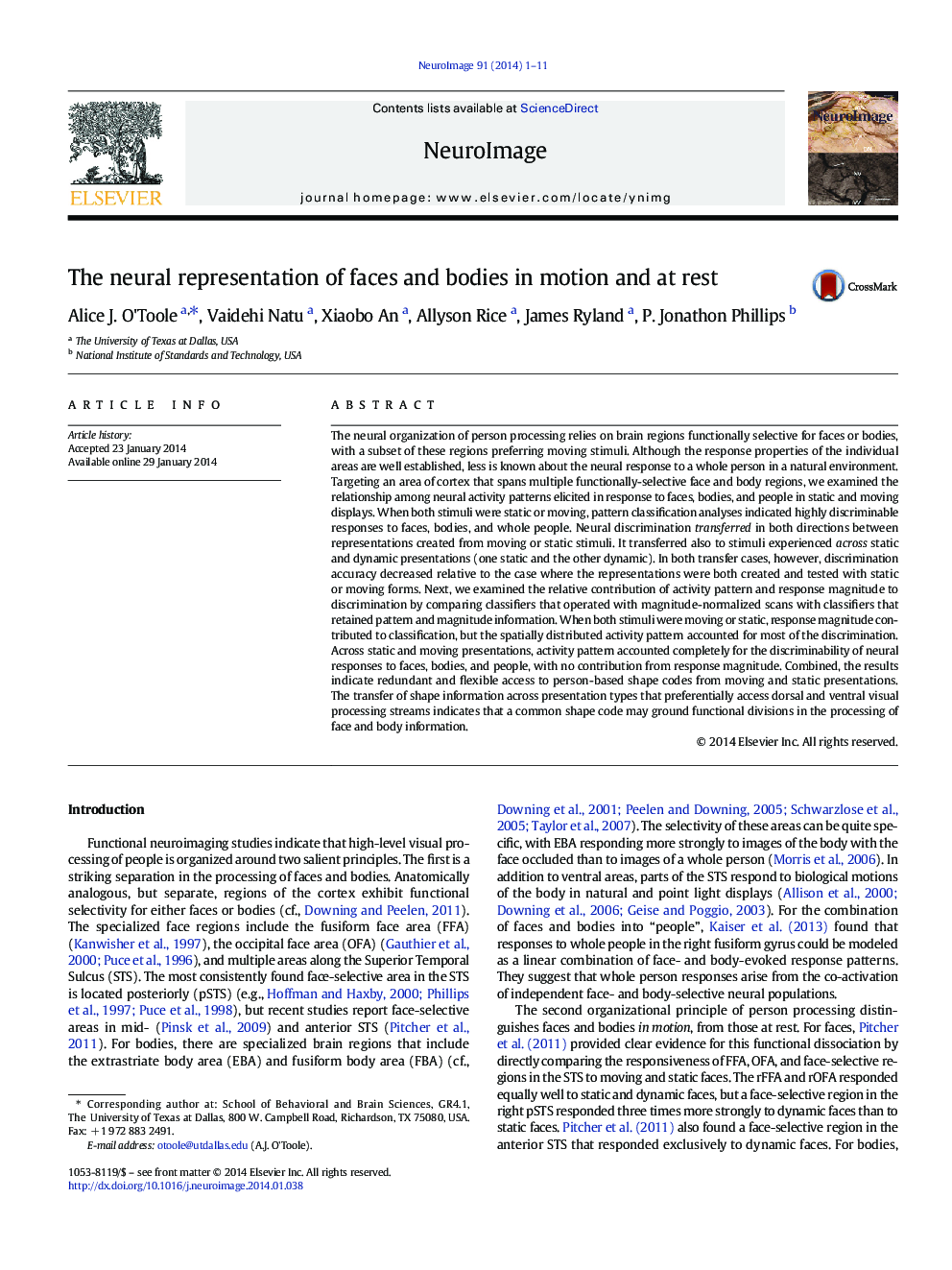| کد مقاله | کد نشریه | سال انتشار | مقاله انگلیسی | نسخه تمام متن |
|---|---|---|---|---|
| 6027591 | 1580914 | 2014 | 11 صفحه PDF | دانلود رایگان |
عنوان انگلیسی مقاله ISI
The neural representation of faces and bodies in motion and at rest
ترجمه فارسی عنوان
نمایش عصبی چهره ها و بدن ها در حرکت و استراحت
دانلود مقاله + سفارش ترجمه
دانلود مقاله ISI انگلیسی
رایگان برای ایرانیان
ترجمه چکیده
سازمان عصبی پردازش فرد مبتنی بر مناطق مغزی است که به طور موثر برای چهره ها یا بدن ها انتخاب می شوند، با یک زیر مجموعه از این مناطق ترجیح می دهند محرک های حرکت کنند. اگر چه خصوصیات واکنش مناطق فردی به خوبی شناخته شده است، در مورد پاسخ عصبی به یک فرد کامل در محیط طبیعی کمتر است. هدف قرار دادن یک ناحیه کورتکس که به چندین ناحیه صورت و بدن انتخابی عمل می کند، ارتباط ما بین الگوهای فعالیت عصبی ایجاد شده در پاسخ به چهره ها، بدن ها و افراد در نمایش های ثابت و متحرک مورد بررسی قرار گرفت. هنگامی که هر دو محرک استاتیک یا حرکتی بودند، تجزیه و تحلیل طبقه بندی الگوها واکنش بسیار واضحی برای چهره، بدن و کل مردم نشان داد. تبعیض عصبی در هر دو جهت بین بازنمودهای ایجاد شده از محرک های متحرک یا استاتیک منتقل می شود. این همچنین به محرک هایی که در نمایش های استاتیک و پویا (با یک استاتیک و پویای دیگر) تجربه می شود، منتقل شده است. با این حال، در هر دو مورد انتقال، دقت نقض تقریبی نسبت به مواردی که در آن بازنمایی ها هر دو ایجاد و آزمایش شده با اشکال استاتیک یا متحرک کاهش می یابد. بعد، سهم نسبی الگوی فعالیت و میزان پاسخ به تبعیض را با مقایسه طبقه بندی هایی که با اسکن های نرمال شده با مقادیر با طبقه بندی هایی که اطلاعات الگوی و اطلاعات را حفظ می کنند بررسی کردیم. هنگامی که هر دو محرک حرکت می کردند یا به صورت ایستا، میزان پاسخ به طبقه بندی کمک می کرد، اما اکثریت تبعیض به شکل فعالیت فضایی توزیع شد. در سراسر نشریات متحرک و متحرک، الگوی فعالیت به طور کامل برای تبعیض پذیری پاسخ های عصبی به چهره ها، بدن ها و افراد، بدون هیچ گونه مشارکت از میزان پاسخ، به حساب می آمد. در مجموع، نتایج نشان می دهد دسترسی های انحصاری و انعطاف پذیر به کد های شکل مبتنی بر شخص از حرکت و ارائه های استاتیک. انتقال اطلاعات شکل از انواع ارائه که به طور پیش فرض جریان پردازش بصری پشتی و درشت دسترسی دارند، نشان می دهد که یک کد شکل معمول ممکن است در پردازش اطلاعات صورت و بدن متمرکز باشد.
موضوعات مرتبط
علوم زیستی و بیوفناوری
علم عصب شناسی
علوم اعصاب شناختی
چکیده انگلیسی
The neural organization of person processing relies on brain regions functionally selective for faces or bodies, with a subset of these regions preferring moving stimuli. Although the response properties of the individual areas are well established, less is known about the neural response to a whole person in a natural environment. Targeting an area of cortex that spans multiple functionally-selective face and body regions, we examined the relationship among neural activity patterns elicited in response to faces, bodies, and people in static and moving displays. When both stimuli were static or moving, pattern classification analyses indicated highly discriminable responses to faces, bodies, and whole people. Neural discrimination transferred in both directions between representations created from moving or static stimuli. It transferred also to stimuli experienced across static and dynamic presentations (one static and the other dynamic). In both transfer cases, however, discrimination accuracy decreased relative to the case where the representations were both created and tested with static or moving forms. Next, we examined the relative contribution of activity pattern and response magnitude to discrimination by comparing classifiers that operated with magnitude-normalized scans with classifiers that retained pattern and magnitude information. When both stimuli were moving or static, response magnitude contributed to classification, but the spatially distributed activity pattern accounted for most of the discrimination. Across static and moving presentations, activity pattern accounted completely for the discriminability of neural responses to faces, bodies, and people, with no contribution from response magnitude. Combined, the results indicate redundant and flexible access to person-based shape codes from moving and static presentations. The transfer of shape information across presentation types that preferentially access dorsal and ventral visual processing streams indicates that a common shape code may ground functional divisions in the processing of face and body information.
ناشر
Database: Elsevier - ScienceDirect (ساینس دایرکت)
Journal: NeuroImage - Volume 91, 1 May 2014, Pages 1-11
Journal: NeuroImage - Volume 91, 1 May 2014, Pages 1-11
نویسندگان
Alice J. O'Toole, Vaidehi Natu, Xiaobo An, Allyson Rice, James Ryland, P. Jonathon Phillips,
